IOT in Business Organization: Data Collection, Storage, Design and Implementation
VerifiedAdded on 2023/06/03
|16
|2172
|159
AI Summary
This article discusses the implementation of IOT in business organizations, including data collection and storage, design and implementation, and result analysis. It also includes a summary of the research and a bibliography of related studies.
Contribute Materials
Your contribution can guide someone’s learning journey. Share your
documents today.
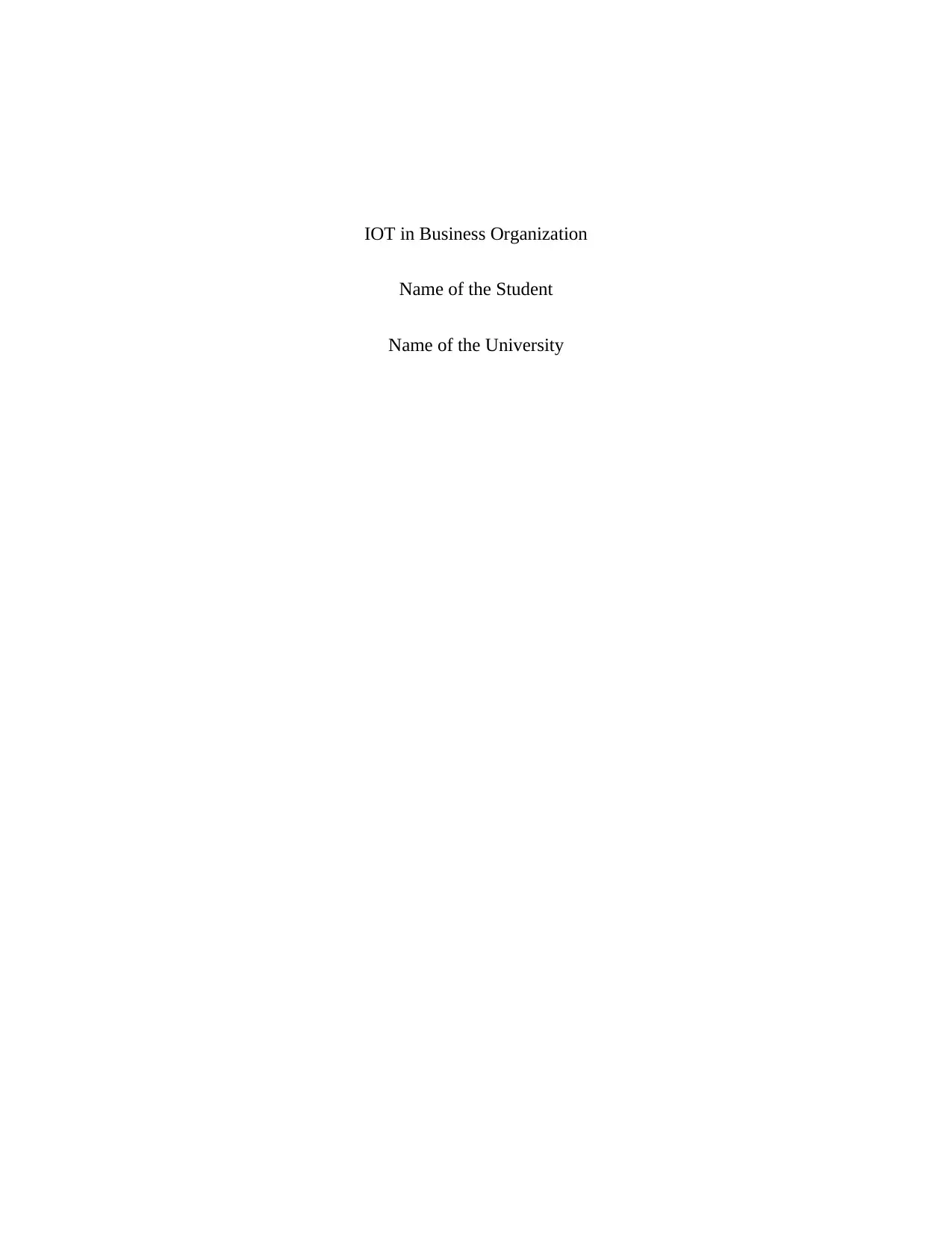
IOT in Business Organization
Name of the Student
Name of the University
Name of the Student
Name of the University
Secure Best Marks with AI Grader
Need help grading? Try our AI Grader for instant feedback on your assignments.
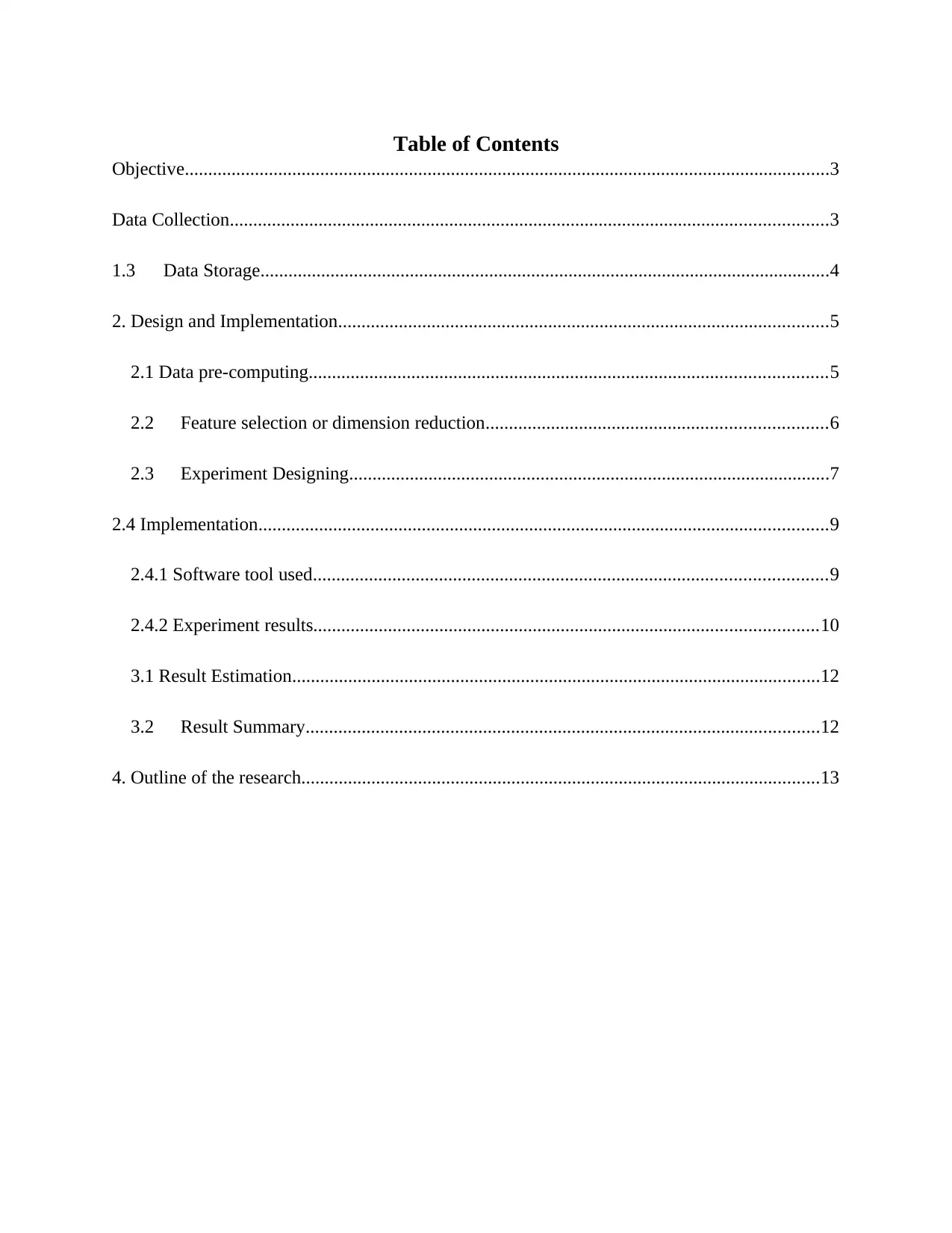
Table of Contents
Objective..........................................................................................................................................3
Data Collection................................................................................................................................3
1.3 Data Storage..........................................................................................................................4
2. Design and Implementation.........................................................................................................5
2.1 Data pre-computing...............................................................................................................5
2.2 Feature selection or dimension reduction.........................................................................6
2.3 Experiment Designing.......................................................................................................7
2.4 Implementation..........................................................................................................................9
2.4.1 Software tool used..............................................................................................................9
2.4.2 Experiment results............................................................................................................10
3.1 Result Estimation.................................................................................................................12
3.2 Result Summary..............................................................................................................12
4. Outline of the research...............................................................................................................13
Objective..........................................................................................................................................3
Data Collection................................................................................................................................3
1.3 Data Storage..........................................................................................................................4
2. Design and Implementation.........................................................................................................5
2.1 Data pre-computing...............................................................................................................5
2.2 Feature selection or dimension reduction.........................................................................6
2.3 Experiment Designing.......................................................................................................7
2.4 Implementation..........................................................................................................................9
2.4.1 Software tool used..............................................................................................................9
2.4.2 Experiment results............................................................................................................10
3.1 Result Estimation.................................................................................................................12
3.2 Result Summary..............................................................................................................12
4. Outline of the research...............................................................................................................13
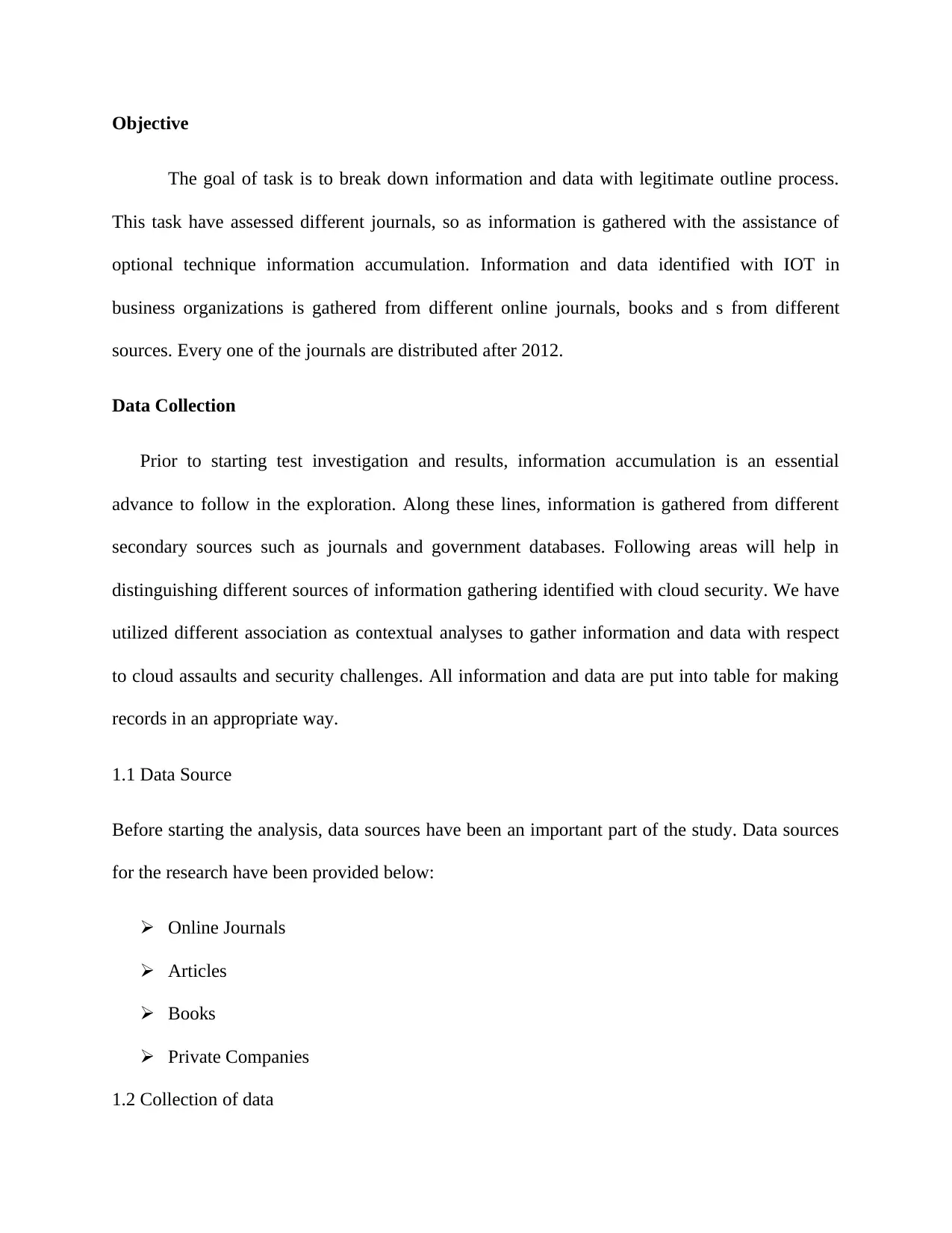
Objective
The goal of task is to break down information and data with legitimate outline process.
This task have assessed different journals, so as information is gathered with the assistance of
optional technique information accumulation. Information and data identified with IOT in
business organizations is gathered from different online journals, books and s from different
sources. Every one of the journals are distributed after 2012.
Data Collection
Prior to starting test investigation and results, information accumulation is an essential
advance to follow in the exploration. Along these lines, information is gathered from different
secondary sources such as journals and government databases. Following areas will help in
distinguishing different sources of information gathering identified with cloud security. We have
utilized different association as contextual analyses to gather information and data with respect
to cloud assaults and security challenges. All information and data are put into table for making
records in an appropriate way.
1.1 Data Source
Before starting the analysis, data sources have been an important part of the study. Data sources
for the research have been provided below:
Online Journals
Articles
Books
Private Companies
1.2 Collection of data
The goal of task is to break down information and data with legitimate outline process.
This task have assessed different journals, so as information is gathered with the assistance of
optional technique information accumulation. Information and data identified with IOT in
business organizations is gathered from different online journals, books and s from different
sources. Every one of the journals are distributed after 2012.
Data Collection
Prior to starting test investigation and results, information accumulation is an essential
advance to follow in the exploration. Along these lines, information is gathered from different
secondary sources such as journals and government databases. Following areas will help in
distinguishing different sources of information gathering identified with cloud security. We have
utilized different association as contextual analyses to gather information and data with respect
to cloud assaults and security challenges. All information and data are put into table for making
records in an appropriate way.
1.1 Data Source
Before starting the analysis, data sources have been an important part of the study. Data sources
for the research have been provided below:
Online Journals
Articles
Books
Private Companies
1.2 Collection of data
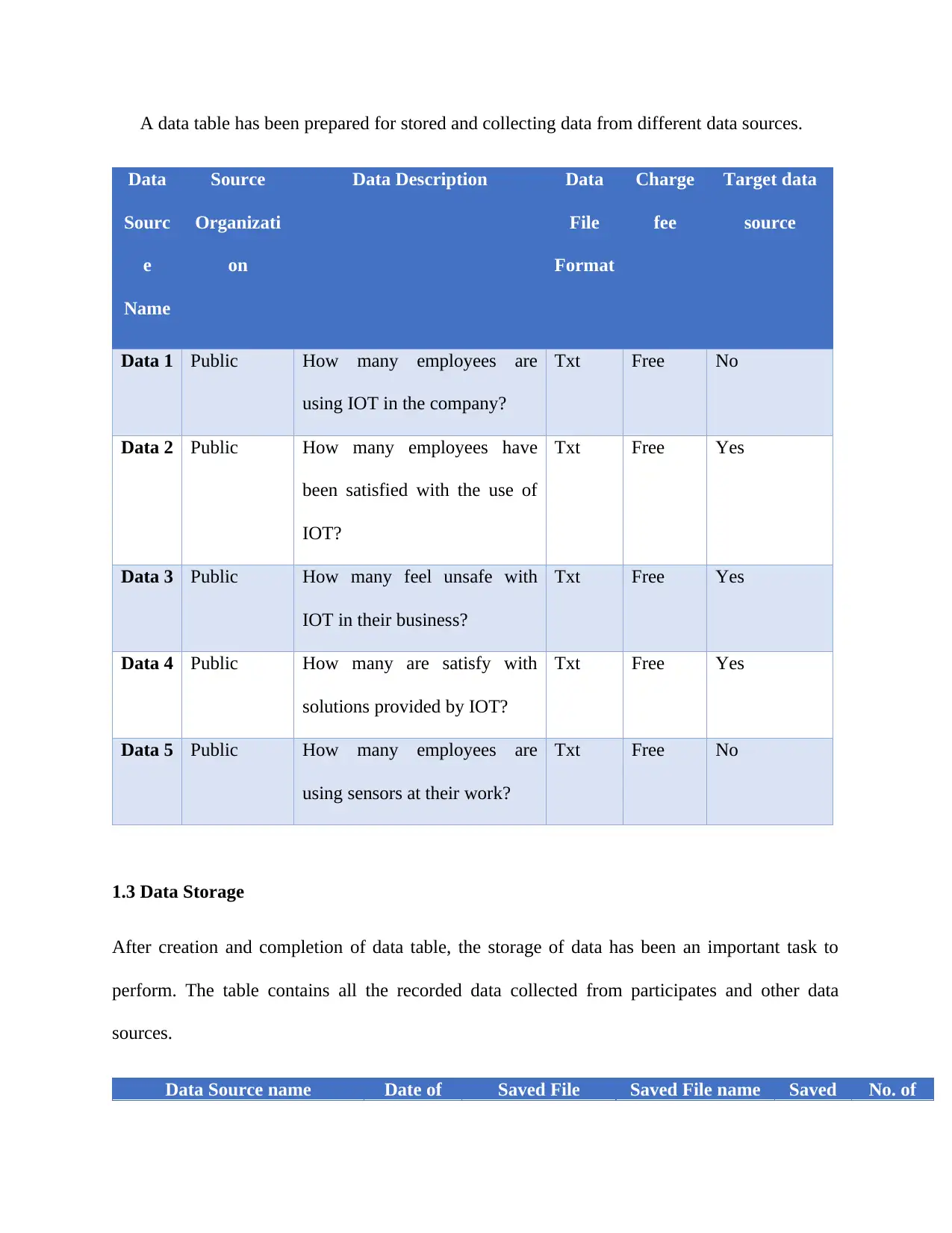
A data table has been prepared for stored and collecting data from different data sources.
Data
Sourc
e
Name
Source
Organizati
on
Data Description Data
File
Format
Charge
fee
Target data
source
Data 1 Public How many employees are
using IOT in the company?
Txt Free No
Data 2 Public How many employees have
been satisfied with the use of
IOT?
Txt Free Yes
Data 3 Public How many feel unsafe with
IOT in their business?
Txt Free Yes
Data 4 Public How many are satisfy with
solutions provided by IOT?
Txt Free Yes
Data 5 Public How many employees are
using sensors at their work?
Txt Free No
1.3 Data Storage
After creation and completion of data table, the storage of data has been an important task to
perform. The table contains all the recorded data collected from participates and other data
sources.
Data Source name Date of Saved File Saved File name Saved No. of
Data
Sourc
e
Name
Source
Organizati
on
Data Description Data
File
Format
Charge
fee
Target data
source
Data 1 Public How many employees are
using IOT in the company?
Txt Free No
Data 2 Public How many employees have
been satisfied with the use of
IOT?
Txt Free Yes
Data 3 Public How many feel unsafe with
IOT in their business?
Txt Free Yes
Data 4 Public How many are satisfy with
solutions provided by IOT?
Txt Free Yes
Data 5 Public How many employees are
using sensors at their work?
Txt Free No
1.3 Data Storage
After creation and completion of data table, the storage of data has been an important task to
perform. The table contains all the recorded data collected from participates and other data
sources.
Data Source name Date of Saved File Saved File name Saved No. of
Secure Best Marks with AI Grader
Need help grading? Try our AI Grader for instant feedback on your assignments.
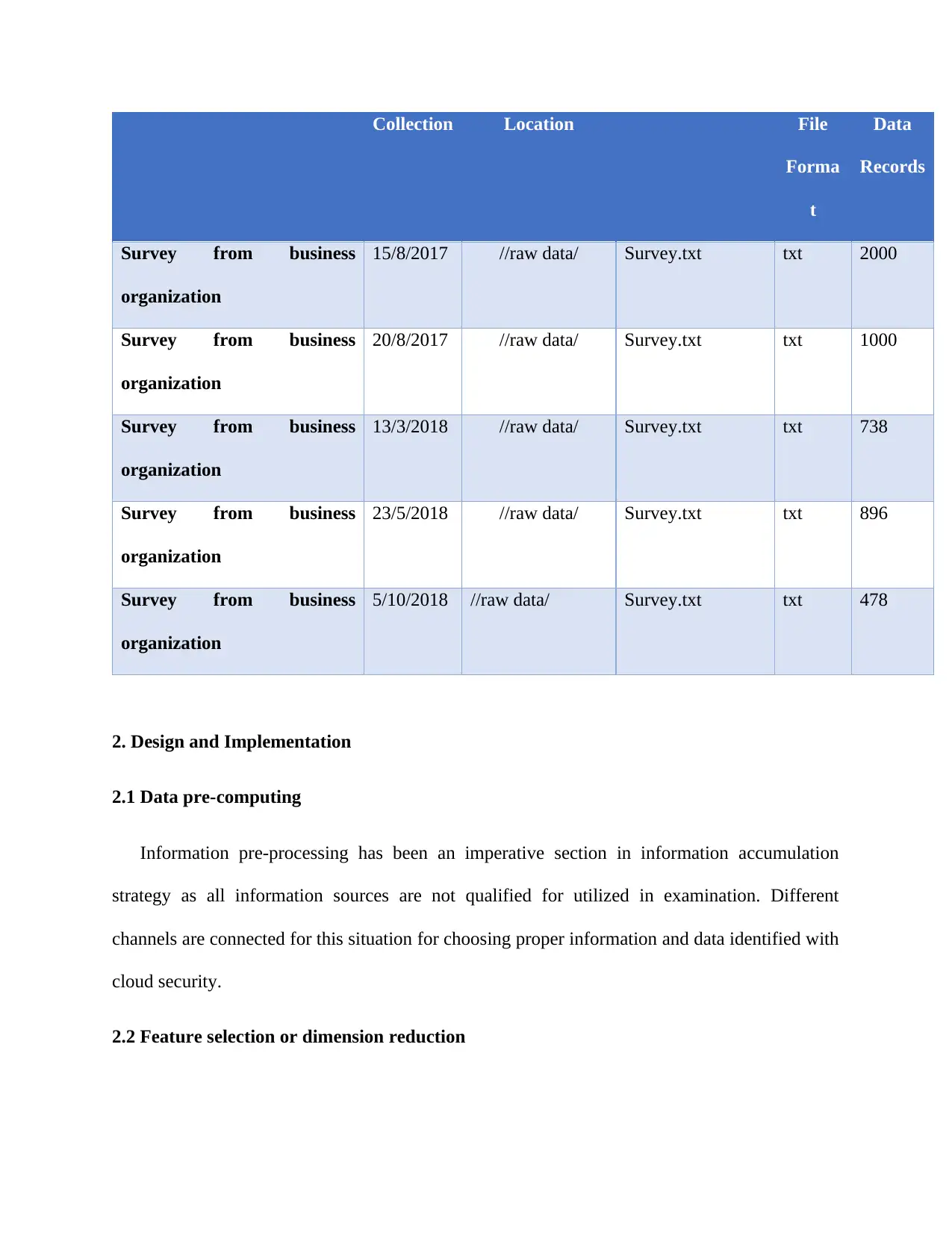
Collection Location File
Forma
t
Data
Records
Survey from business
organization
15/8/2017 //raw data/ Survey.txt txt 2000
Survey from business
organization
20/8/2017 //raw data/ Survey.txt txt 1000
Survey from business
organization
13/3/2018 //raw data/ Survey.txt txt 738
Survey from business
organization
23/5/2018 //raw data/ Survey.txt txt 896
Survey from business
organization
5/10/2018 //raw data/ Survey.txt txt 478
2. Design and Implementation
2.1 Data pre-computing
Information pre-processing has been an imperative section in information accumulation
strategy as all information sources are not qualified for utilized in examination. Different
channels are connected for this situation for choosing proper information and data identified with
cloud security.
2.2 Feature selection or dimension reduction
Forma
t
Data
Records
Survey from business
organization
15/8/2017 //raw data/ Survey.txt txt 2000
Survey from business
organization
20/8/2017 //raw data/ Survey.txt txt 1000
Survey from business
organization
13/3/2018 //raw data/ Survey.txt txt 738
Survey from business
organization
23/5/2018 //raw data/ Survey.txt txt 896
Survey from business
organization
5/10/2018 //raw data/ Survey.txt txt 478
2. Design and Implementation
2.1 Data pre-computing
Information pre-processing has been an imperative section in information accumulation
strategy as all information sources are not qualified for utilized in examination. Different
channels are connected for this situation for choosing proper information and data identified with
cloud security.
2.2 Feature selection or dimension reduction
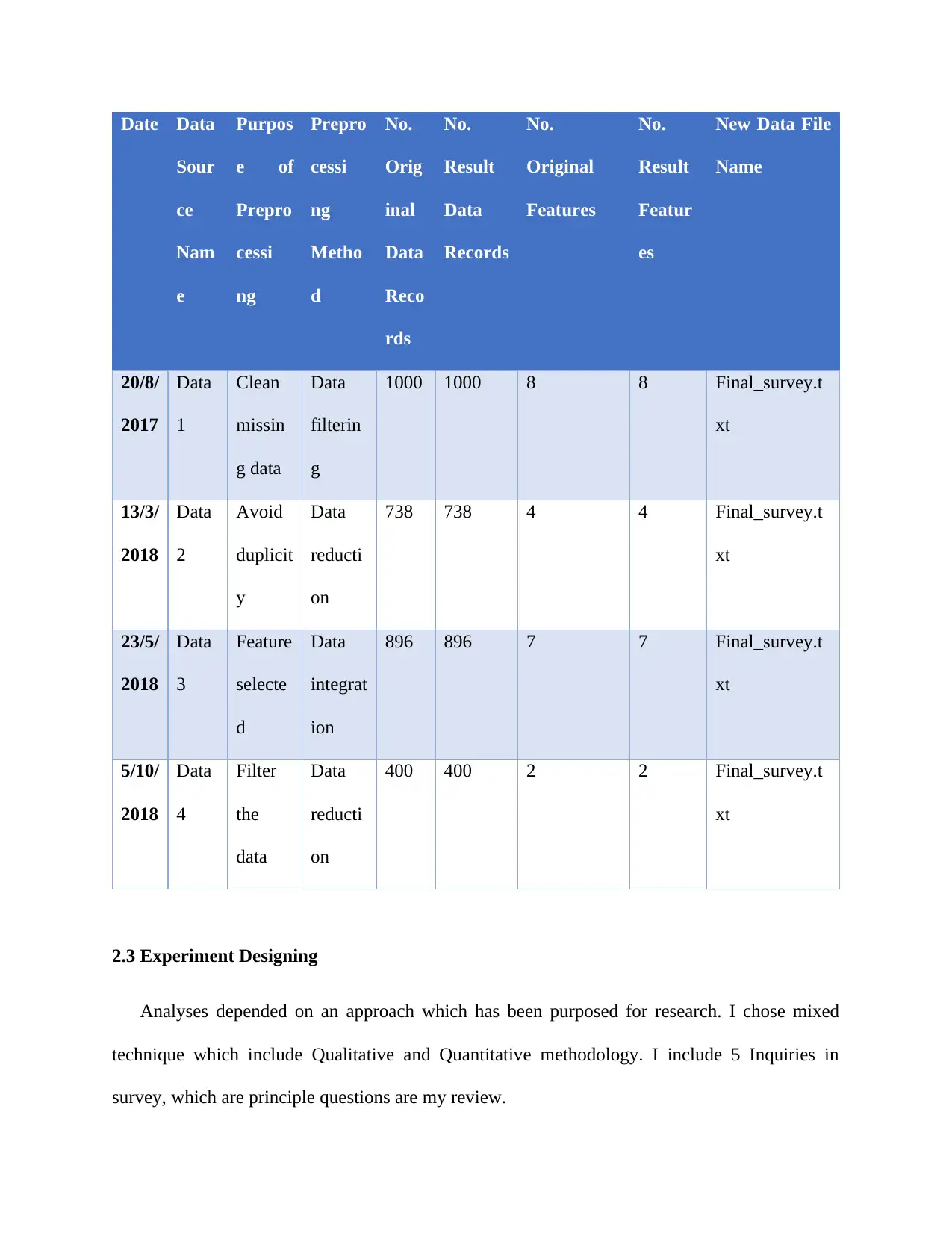
Date Data
Sour
ce
Nam
e
Purpos
e of
Prepro
cessi
ng
Prepro
cessi
ng
Metho
d
No.
Orig
inal
Data
Reco
rds
No.
Result
Data
Records
No.
Original
Features
No.
Result
Featur
es
New Data File
Name
20/8/
2017
Data
1
Clean
missin
g data
Data
filterin
g
1000 1000 8 8 Final_survey.t
xt
13/3/
2018
Data
2
Avoid
duplicit
y
Data
reducti
on
738 738 4 4 Final_survey.t
xt
23/5/
2018
Data
3
Feature
selecte
d
Data
integrat
ion
896 896 7 7 Final_survey.t
xt
5/10/
2018
Data
4
Filter
the
data
Data
reducti
on
400 400 2 2 Final_survey.t
xt
2.3 Experiment Designing
Analyses depended on an approach which has been purposed for research. I chose mixed
technique which include Qualitative and Quantitative methodology. I include 5 Inquiries in
survey, which are principle questions are my review.
Sour
ce
Nam
e
Purpos
e of
Prepro
cessi
ng
Prepro
cessi
ng
Metho
d
No.
Orig
inal
Data
Reco
rds
No.
Result
Data
Records
No.
Original
Features
No.
Result
Featur
es
New Data File
Name
20/8/
2017
Data
1
Clean
missin
g data
Data
filterin
g
1000 1000 8 8 Final_survey.t
xt
13/3/
2018
Data
2
Avoid
duplicit
y
Data
reducti
on
738 738 4 4 Final_survey.t
xt
23/5/
2018
Data
3
Feature
selecte
d
Data
integrat
ion
896 896 7 7 Final_survey.t
xt
5/10/
2018
Data
4
Filter
the
data
Data
reducti
on
400 400 2 2 Final_survey.t
xt
2.3 Experiment Designing
Analyses depended on an approach which has been purposed for research. I chose mixed
technique which include Qualitative and Quantitative methodology. I include 5 Inquiries in
survey, which are principle questions are my review.
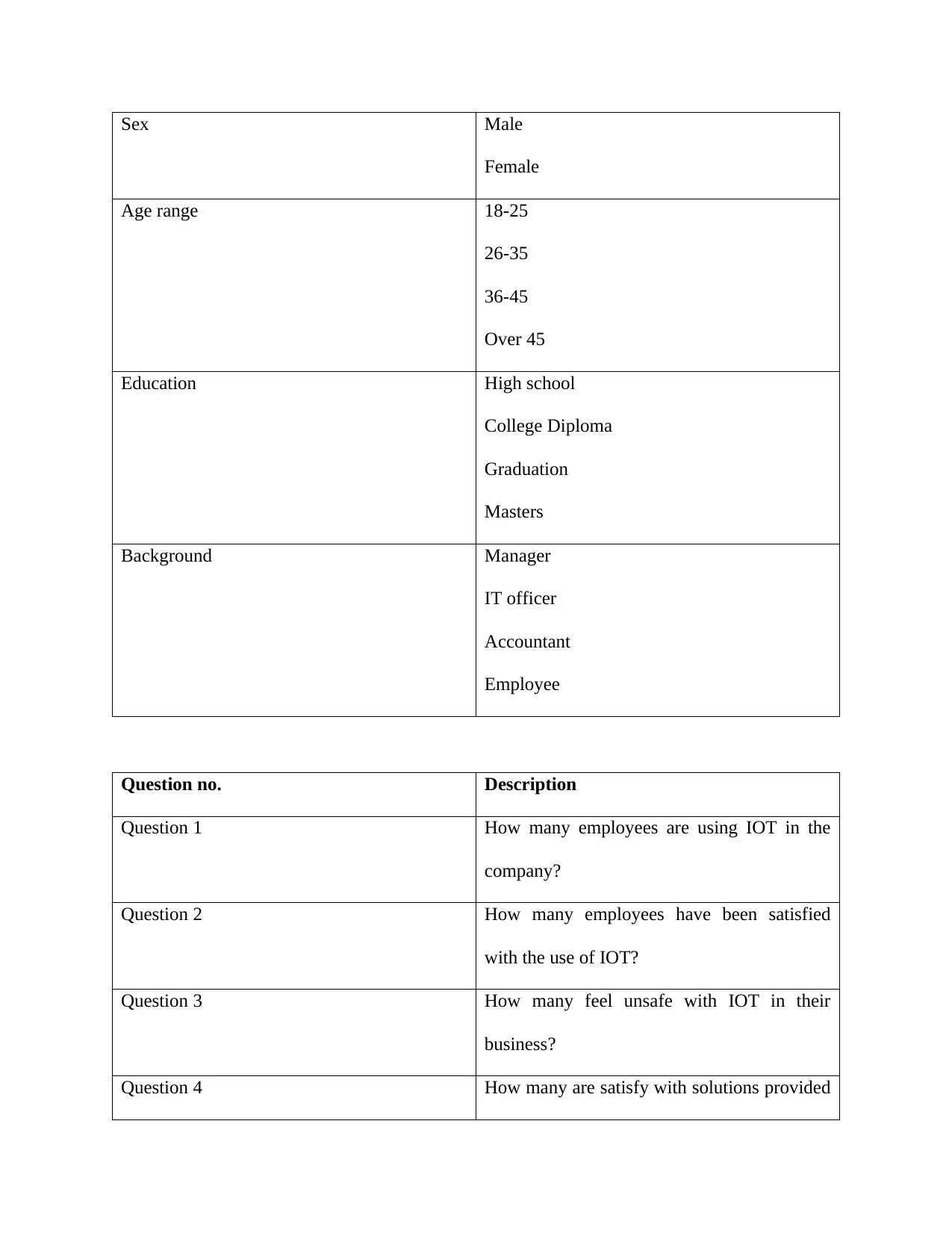
Sex Male
Female
Age range 18-25
26-35
36-45
Over 45
Education High school
College Diploma
Graduation
Masters
Background Manager
IT officer
Accountant
Employee
Question no. Description
Question 1 How many employees are using IOT in the
company?
Question 2 How many employees have been satisfied
with the use of IOT?
Question 3 How many feel unsafe with IOT in their
business?
Question 4 How many are satisfy with solutions provided
Female
Age range 18-25
26-35
36-45
Over 45
Education High school
College Diploma
Graduation
Masters
Background Manager
IT officer
Accountant
Employee
Question no. Description
Question 1 How many employees are using IOT in the
company?
Question 2 How many employees have been satisfied
with the use of IOT?
Question 3 How many feel unsafe with IOT in their
business?
Question 4 How many are satisfy with solutions provided
Paraphrase This Document
Need a fresh take? Get an instant paraphrase of this document with our AI Paraphraser
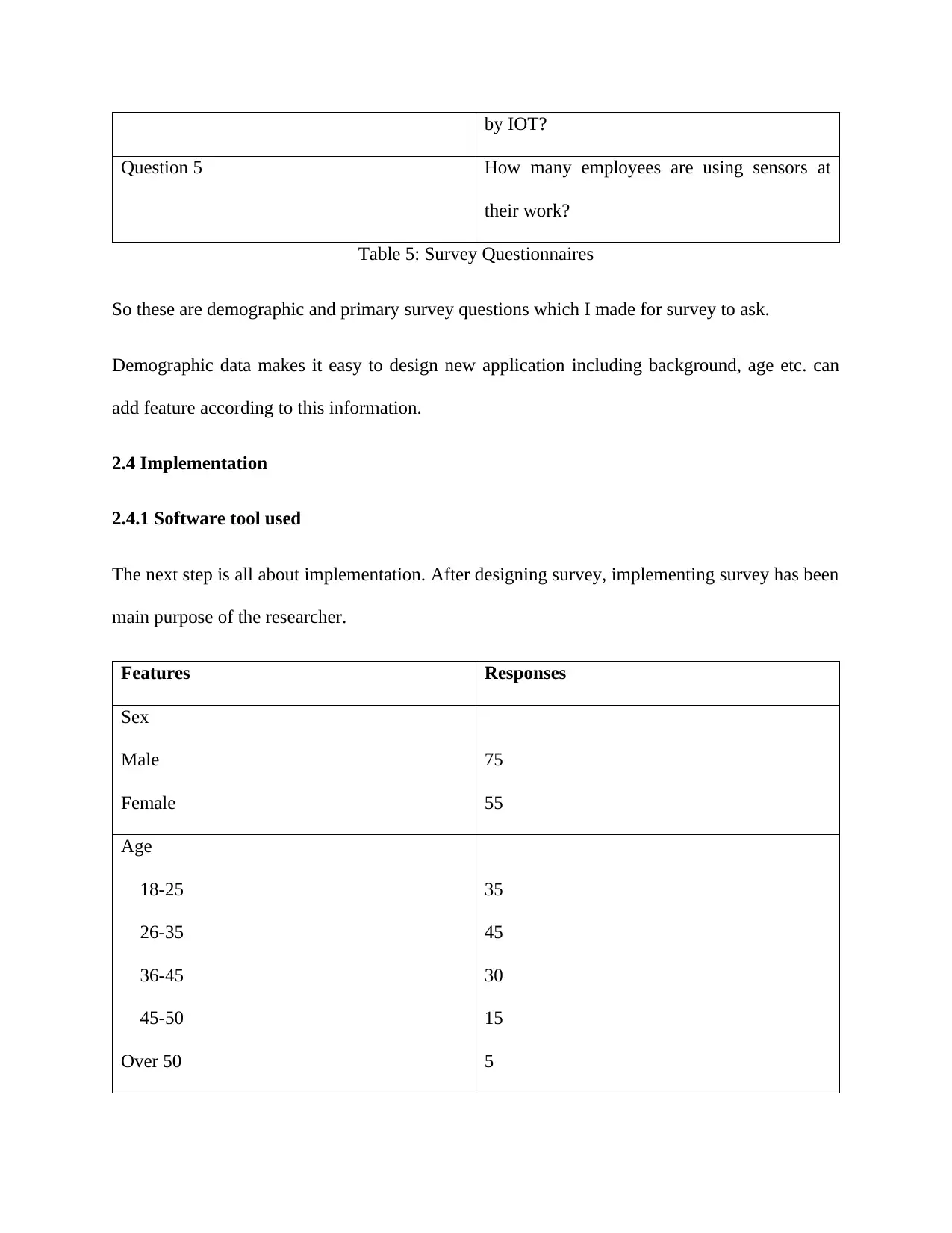
by IOT?
Question 5 How many employees are using sensors at
their work?
Table 5: Survey Questionnaires
So these are demographic and primary survey questions which I made for survey to ask.
Demographic data makes it easy to design new application including background, age etc. can
add feature according to this information.
2.4 Implementation
2.4.1 Software tool used
The next step is all about implementation. After designing survey, implementing survey has been
main purpose of the researcher.
Features Responses
Sex
Male
Female
75
55
Age
18-25
26-35
36-45
45-50
Over 50
35
45
30
15
5
Question 5 How many employees are using sensors at
their work?
Table 5: Survey Questionnaires
So these are demographic and primary survey questions which I made for survey to ask.
Demographic data makes it easy to design new application including background, age etc. can
add feature according to this information.
2.4 Implementation
2.4.1 Software tool used
The next step is all about implementation. After designing survey, implementing survey has been
main purpose of the researcher.
Features Responses
Sex
Male
Female
75
55
Age
18-25
26-35
36-45
45-50
Over 50
35
45
30
15
5
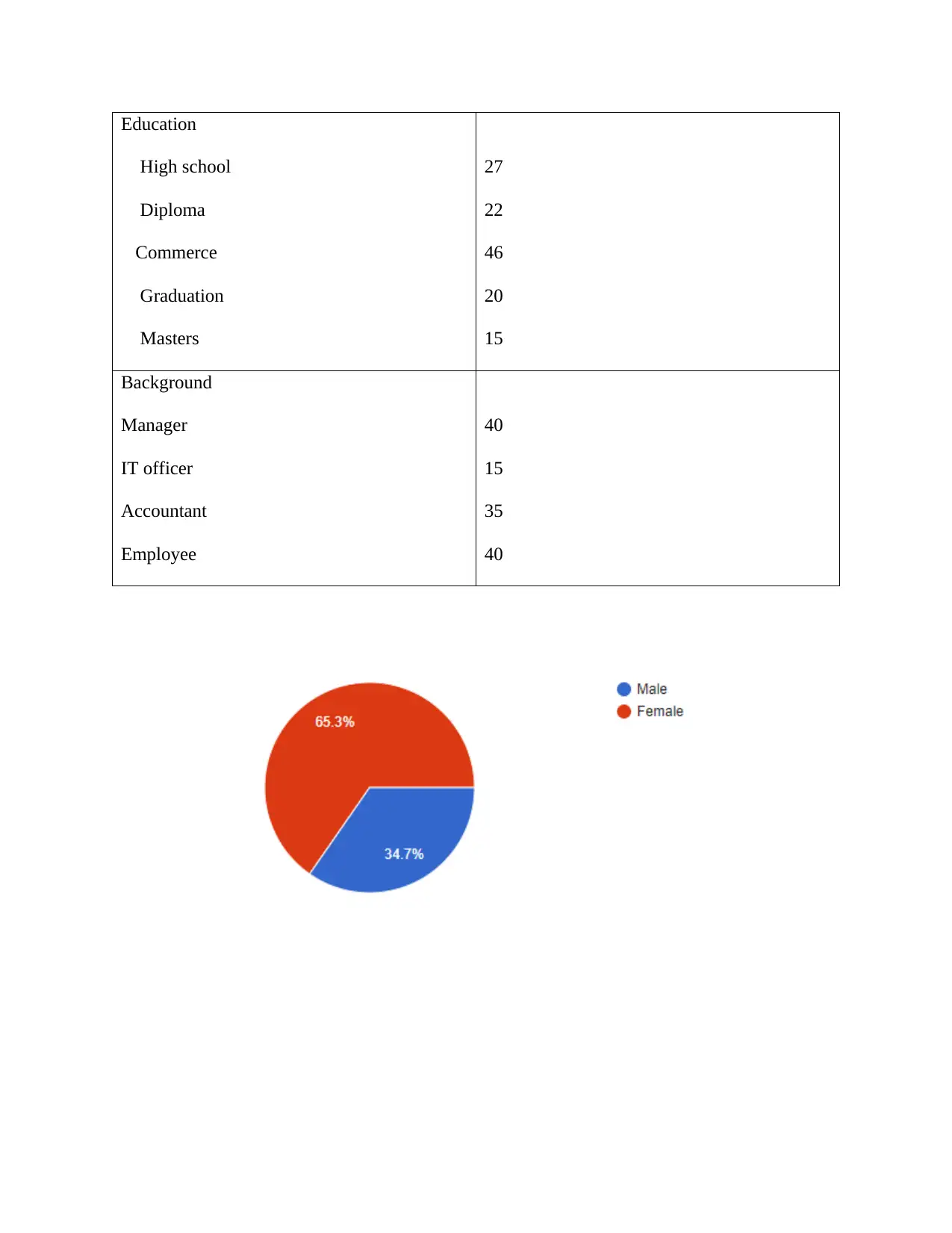
Education
High school
Diploma
Commerce
Graduation
Masters
27
22
46
20
15
Background
Manager
IT officer
Accountant
Employee
40
15
35
40
High school
Diploma
Commerce
Graduation
Masters
27
22
46
20
15
Background
Manager
IT officer
Accountant
Employee
40
15
35
40
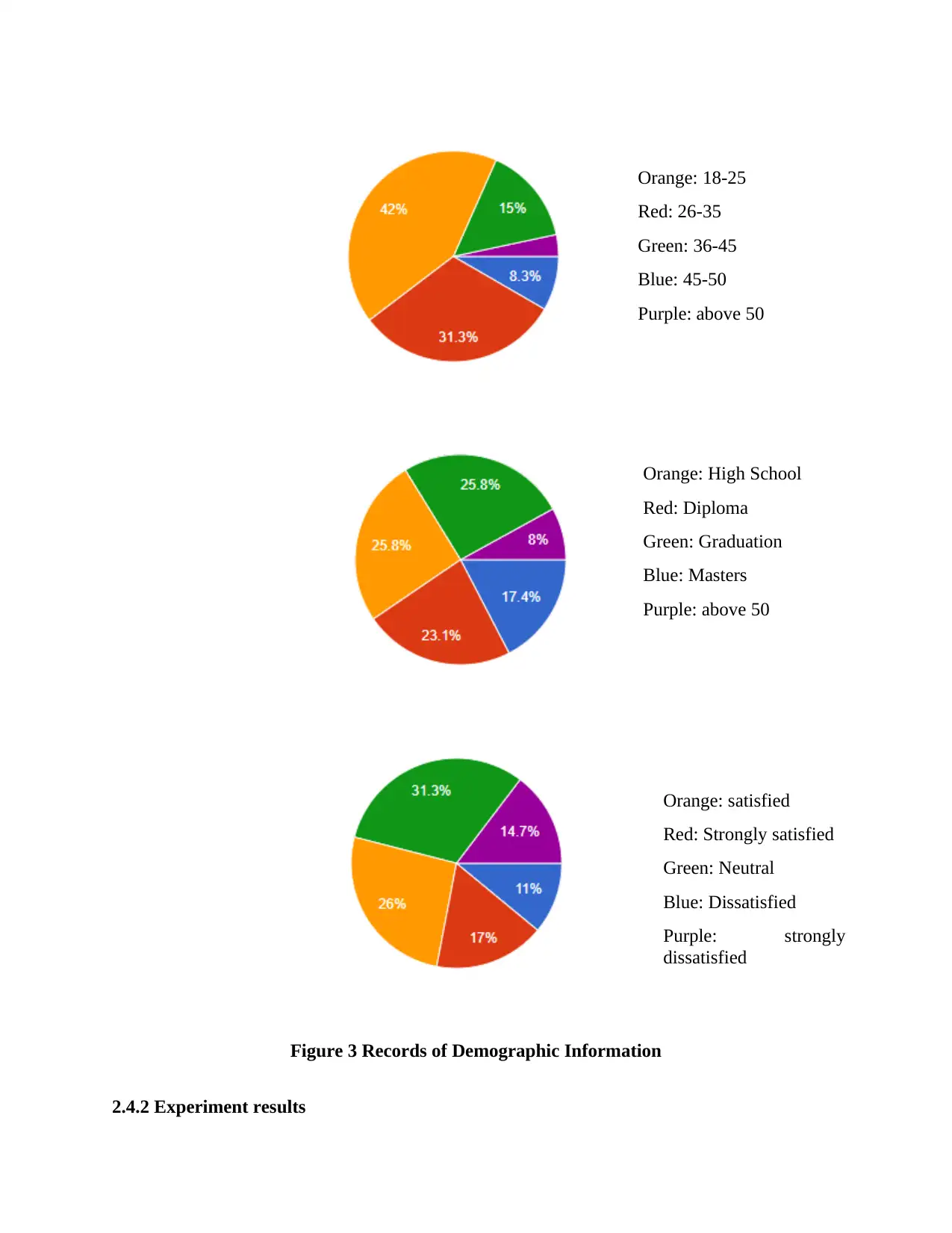
Figure 3 Records of Demographic Information
2.4.2 Experiment results
Orange: 18-25
Red: 26-35
Green: 36-45
Blue: 45-50
Purple: above 50
Orange: High School
Red: Diploma
Green: Graduation
Blue: Masters
Purple: above 50
Orange: satisfied
Red: Strongly satisfied
Green: Neutral
Blue: Dissatisfied
Purple: strongly
dissatisfied
2.4.2 Experiment results
Orange: 18-25
Red: 26-35
Green: 36-45
Blue: 45-50
Purple: above 50
Orange: High School
Red: Diploma
Green: Graduation
Blue: Masters
Purple: above 50
Orange: satisfied
Red: Strongly satisfied
Green: Neutral
Blue: Dissatisfied
Purple: strongly
dissatisfied
Secure Best Marks with AI Grader
Need help grading? Try our AI Grader for instant feedback on your assignments.
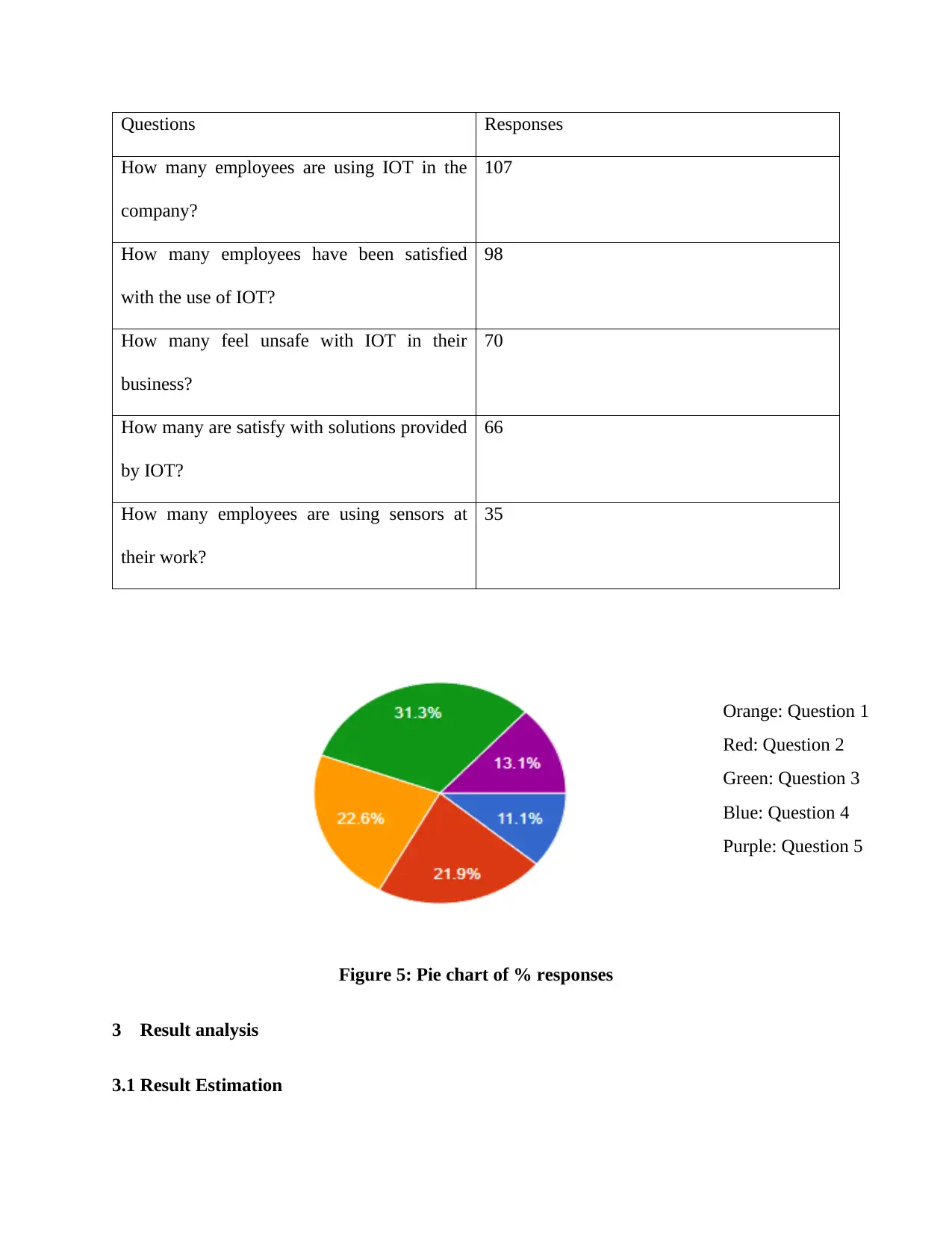
Questions Responses
How many employees are using IOT in the
company?
107
How many employees have been satisfied
with the use of IOT?
98
How many feel unsafe with IOT in their
business?
70
How many are satisfy with solutions provided
by IOT?
66
How many employees are using sensors at
their work?
35
Figure 5: Pie chart of % responses
3 Result analysis
3.1 Result Estimation
Orange: Question 1
Red: Question 2
Green: Question 3
Blue: Question 4
Purple: Question 5
How many employees are using IOT in the
company?
107
How many employees have been satisfied
with the use of IOT?
98
How many feel unsafe with IOT in their
business?
70
How many are satisfy with solutions provided
by IOT?
66
How many employees are using sensors at
their work?
35
Figure 5: Pie chart of % responses
3 Result analysis
3.1 Result Estimation
Orange: Question 1
Red: Question 2
Green: Question 3
Blue: Question 4
Purple: Question 5
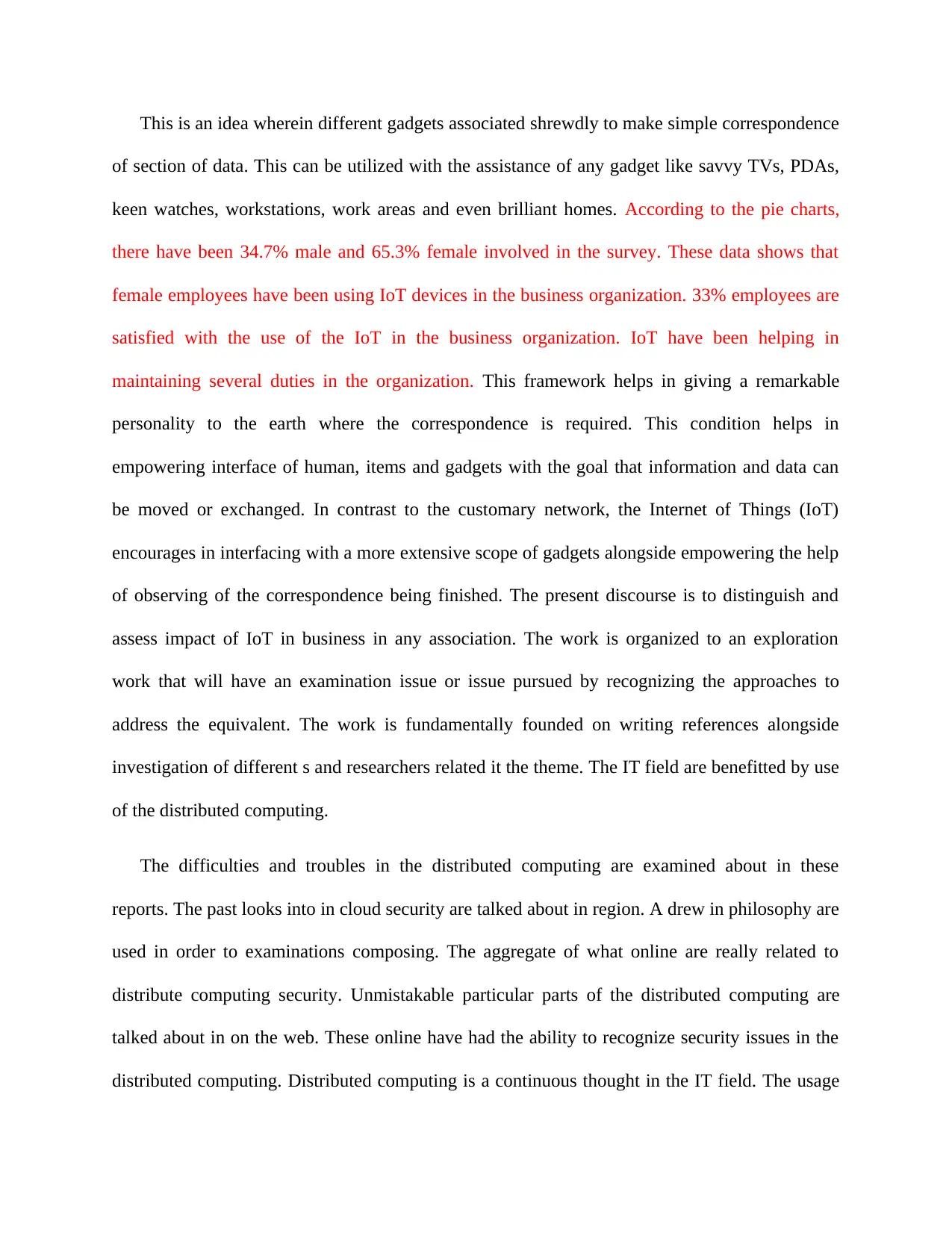
This is an idea wherein different gadgets associated shrewdly to make simple correspondence
of section of data. This can be utilized with the assistance of any gadget like savvy TVs, PDAs,
keen watches, workstations, work areas and even brilliant homes. According to the pie charts,
there have been 34.7% male and 65.3% female involved in the survey. These data shows that
female employees have been using IoT devices in the business organization. 33% employees are
satisfied with the use of the IoT in the business organization. IoT have been helping in
maintaining several duties in the organization. This framework helps in giving a remarkable
personality to the earth where the correspondence is required. This condition helps in
empowering interface of human, items and gadgets with the goal that information and data can
be moved or exchanged. In contrast to the customary network, the Internet of Things (IoT)
encourages in interfacing with a more extensive scope of gadgets alongside empowering the help
of observing of the correspondence being finished. The present discourse is to distinguish and
assess impact of IoT in business in any association. The work is organized to an exploration
work that will have an examination issue or issue pursued by recognizing the approaches to
address the equivalent. The work is fundamentally founded on writing references alongside
investigation of different s and researchers related it the theme. The IT field are benefitted by use
of the distributed computing.
The difficulties and troubles in the distributed computing are examined about in these
reports. The past looks into in cloud security are talked about in region. A drew in philosophy are
used in order to examinations composing. The aggregate of what online are really related to
distribute computing security. Unmistakable particular parts of the distributed computing are
talked about in on the web. These online have had the ability to recognize security issues in the
distributed computing. Distributed computing is a continuous thought in the IT field. The usage
of section of data. This can be utilized with the assistance of any gadget like savvy TVs, PDAs,
keen watches, workstations, work areas and even brilliant homes. According to the pie charts,
there have been 34.7% male and 65.3% female involved in the survey. These data shows that
female employees have been using IoT devices in the business organization. 33% employees are
satisfied with the use of the IoT in the business organization. IoT have been helping in
maintaining several duties in the organization. This framework helps in giving a remarkable
personality to the earth where the correspondence is required. This condition helps in
empowering interface of human, items and gadgets with the goal that information and data can
be moved or exchanged. In contrast to the customary network, the Internet of Things (IoT)
encourages in interfacing with a more extensive scope of gadgets alongside empowering the help
of observing of the correspondence being finished. The present discourse is to distinguish and
assess impact of IoT in business in any association. The work is organized to an exploration
work that will have an examination issue or issue pursued by recognizing the approaches to
address the equivalent. The work is fundamentally founded on writing references alongside
investigation of different s and researchers related it the theme. The IT field are benefitted by use
of the distributed computing.
The difficulties and troubles in the distributed computing are examined about in these
reports. The past looks into in cloud security are talked about in region. A drew in philosophy are
used in order to examinations composing. The aggregate of what online are really related to
distribute computing security. Unmistakable particular parts of the distributed computing are
talked about in on the web. These online have had the ability to recognize security issues in the
distributed computing. Distributed computing is a continuous thought in the IT field. The usage
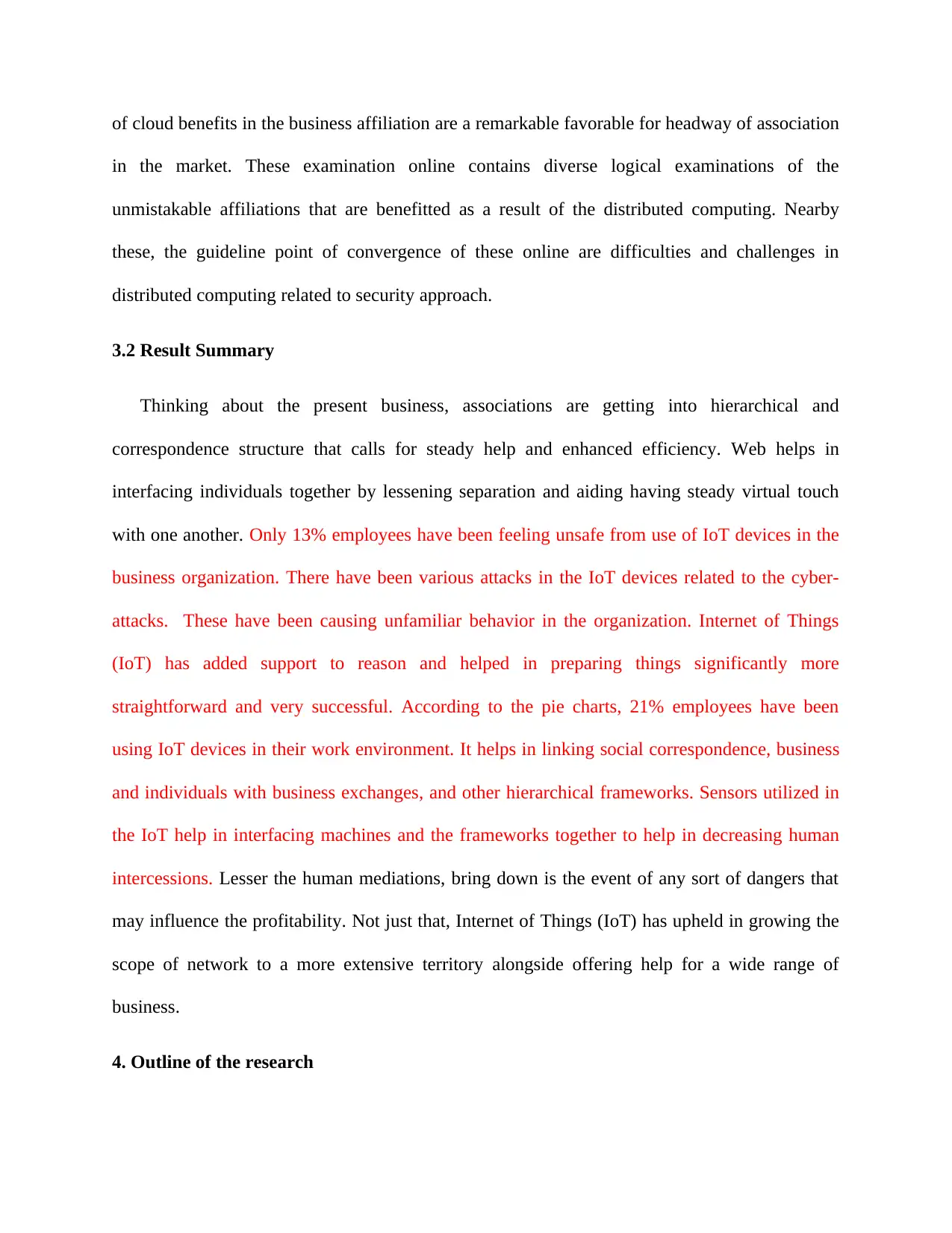
of cloud benefits in the business affiliation are a remarkable favorable for headway of association
in the market. These examination online contains diverse logical examinations of the
unmistakable affiliations that are benefitted as a result of the distributed computing. Nearby
these, the guideline point of convergence of these online are difficulties and challenges in
distributed computing related to security approach.
3.2 Result Summary
Thinking about the present business, associations are getting into hierarchical and
correspondence structure that calls for steady help and enhanced efficiency. Web helps in
interfacing individuals together by lessening separation and aiding having steady virtual touch
with one another. Only 13% employees have been feeling unsafe from use of IoT devices in the
business organization. There have been various attacks in the IoT devices related to the cyber-
attacks. These have been causing unfamiliar behavior in the organization. Internet of Things
(IoT) has added support to reason and helped in preparing things significantly more
straightforward and very successful. According to the pie charts, 21% employees have been
using IoT devices in their work environment. It helps in linking social correspondence, business
and individuals with business exchanges, and other hierarchical frameworks. Sensors utilized in
the IoT help in interfacing machines and the frameworks together to help in decreasing human
intercessions. Lesser the human mediations, bring down is the event of any sort of dangers that
may influence the profitability. Not just that, Internet of Things (IoT) has upheld in growing the
scope of network to a more extensive territory alongside offering help for a wide range of
business.
4. Outline of the research
in the market. These examination online contains diverse logical examinations of the
unmistakable affiliations that are benefitted as a result of the distributed computing. Nearby
these, the guideline point of convergence of these online are difficulties and challenges in
distributed computing related to security approach.
3.2 Result Summary
Thinking about the present business, associations are getting into hierarchical and
correspondence structure that calls for steady help and enhanced efficiency. Web helps in
interfacing individuals together by lessening separation and aiding having steady virtual touch
with one another. Only 13% employees have been feeling unsafe from use of IoT devices in the
business organization. There have been various attacks in the IoT devices related to the cyber-
attacks. These have been causing unfamiliar behavior in the organization. Internet of Things
(IoT) has added support to reason and helped in preparing things significantly more
straightforward and very successful. According to the pie charts, 21% employees have been
using IoT devices in their work environment. It helps in linking social correspondence, business
and individuals with business exchanges, and other hierarchical frameworks. Sensors utilized in
the IoT help in interfacing machines and the frameworks together to help in decreasing human
intercessions. Lesser the human mediations, bring down is the event of any sort of dangers that
may influence the profitability. Not just that, Internet of Things (IoT) has upheld in growing the
scope of network to a more extensive territory alongside offering help for a wide range of
business.
4. Outline of the research
Paraphrase This Document
Need a fresh take? Get an instant paraphrase of this document with our AI Paraphraser
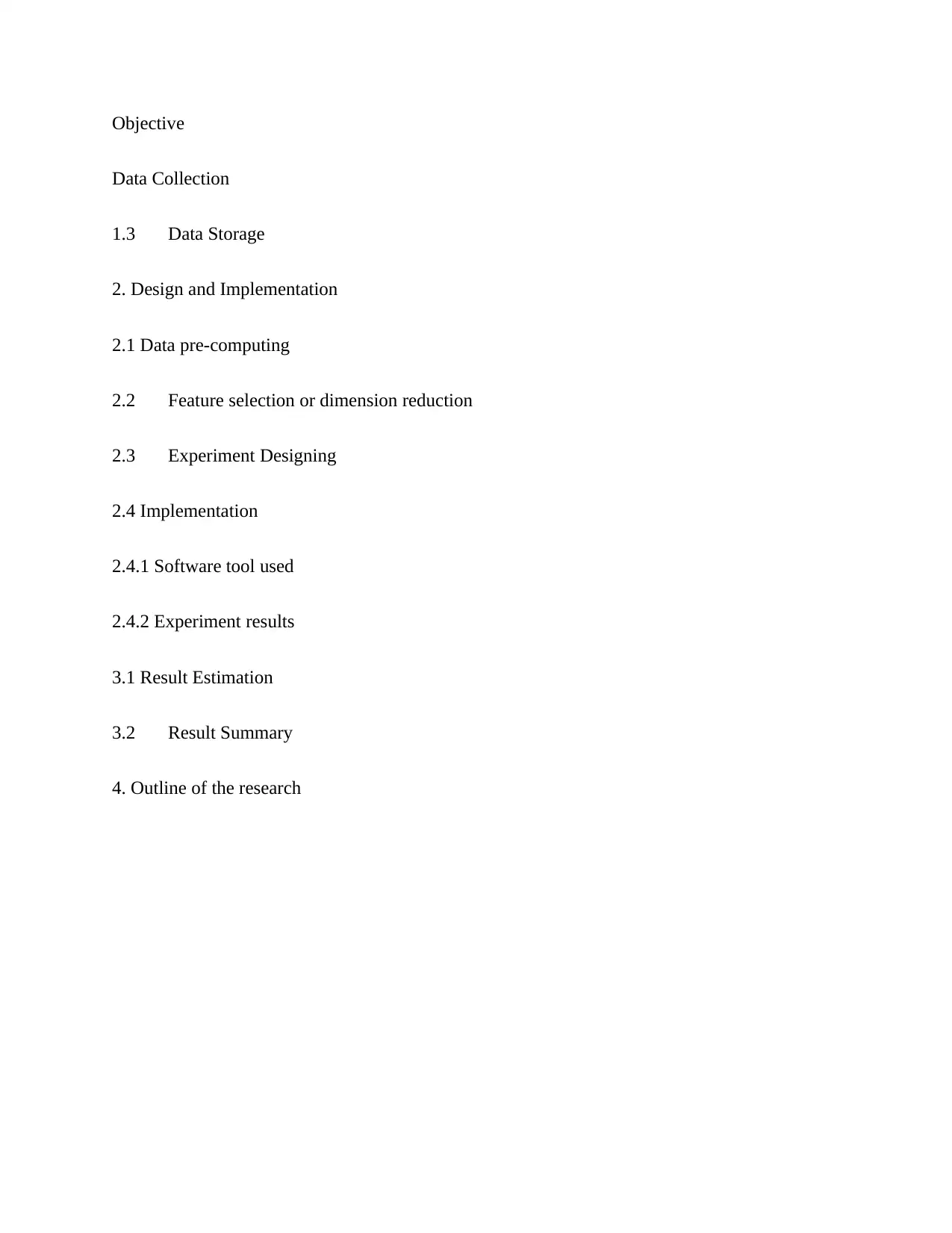
Objective
Data Collection
1.3 Data Storage
2. Design and Implementation
2.1 Data pre-computing
2.2 Feature selection or dimension reduction
2.3 Experiment Designing
2.4 Implementation
2.4.1 Software tool used
2.4.2 Experiment results
3.1 Result Estimation
3.2 Result Summary
4. Outline of the research
Data Collection
1.3 Data Storage
2. Design and Implementation
2.1 Data pre-computing
2.2 Feature selection or dimension reduction
2.3 Experiment Designing
2.4 Implementation
2.4.1 Software tool used
2.4.2 Experiment results
3.1 Result Estimation
3.2 Result Summary
4. Outline of the research
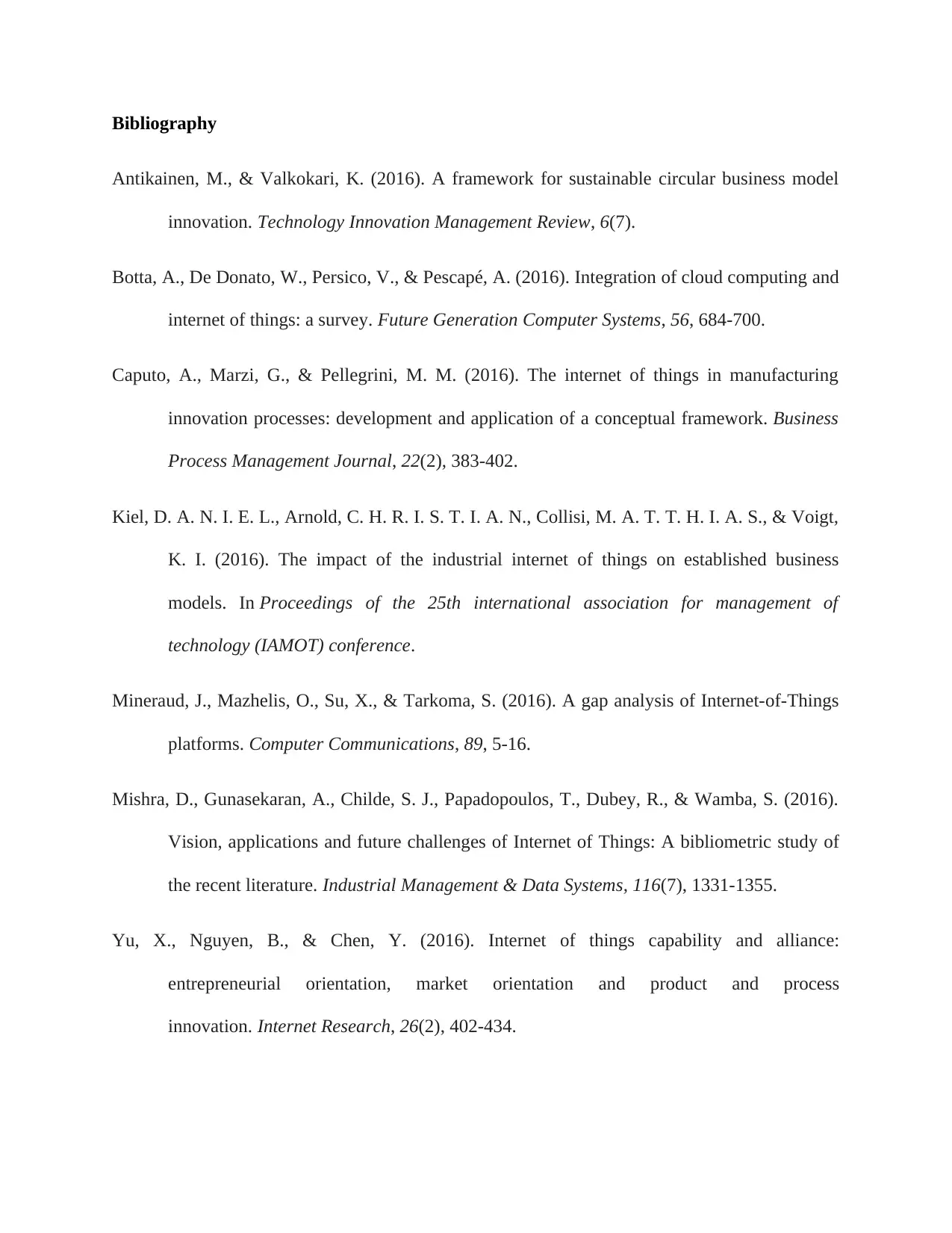
Bibliography
Antikainen, M., & Valkokari, K. (2016). A framework for sustainable circular business model
innovation. Technology Innovation Management Review, 6(7).
Botta, A., De Donato, W., Persico, V., & Pescapé, A. (2016). Integration of cloud computing and
internet of things: a survey. Future Generation Computer Systems, 56, 684-700.
Caputo, A., Marzi, G., & Pellegrini, M. M. (2016). The internet of things in manufacturing
innovation processes: development and application of a conceptual framework. Business
Process Management Journal, 22(2), 383-402.
Kiel, D. A. N. I. E. L., Arnold, C. H. R. I. S. T. I. A. N., Collisi, M. A. T. T. H. I. A. S., & Voigt,
K. I. (2016). The impact of the industrial internet of things on established business
models. In Proceedings of the 25th international association for management of
technology (IAMOT) conference.
Mineraud, J., Mazhelis, O., Su, X., & Tarkoma, S. (2016). A gap analysis of Internet-of-Things
platforms. Computer Communications, 89, 5-16.
Mishra, D., Gunasekaran, A., Childe, S. J., Papadopoulos, T., Dubey, R., & Wamba, S. (2016).
Vision, applications and future challenges of Internet of Things: A bibliometric study of
the recent literature. Industrial Management & Data Systems, 116(7), 1331-1355.
Yu, X., Nguyen, B., & Chen, Y. (2016). Internet of things capability and alliance:
entrepreneurial orientation, market orientation and product and process
innovation. Internet Research, 26(2), 402-434.
Antikainen, M., & Valkokari, K. (2016). A framework for sustainable circular business model
innovation. Technology Innovation Management Review, 6(7).
Botta, A., De Donato, W., Persico, V., & Pescapé, A. (2016). Integration of cloud computing and
internet of things: a survey. Future Generation Computer Systems, 56, 684-700.
Caputo, A., Marzi, G., & Pellegrini, M. M. (2016). The internet of things in manufacturing
innovation processes: development and application of a conceptual framework. Business
Process Management Journal, 22(2), 383-402.
Kiel, D. A. N. I. E. L., Arnold, C. H. R. I. S. T. I. A. N., Collisi, M. A. T. T. H. I. A. S., & Voigt,
K. I. (2016). The impact of the industrial internet of things on established business
models. In Proceedings of the 25th international association for management of
technology (IAMOT) conference.
Mineraud, J., Mazhelis, O., Su, X., & Tarkoma, S. (2016). A gap analysis of Internet-of-Things
platforms. Computer Communications, 89, 5-16.
Mishra, D., Gunasekaran, A., Childe, S. J., Papadopoulos, T., Dubey, R., & Wamba, S. (2016).
Vision, applications and future challenges of Internet of Things: A bibliometric study of
the recent literature. Industrial Management & Data Systems, 116(7), 1331-1355.
Yu, X., Nguyen, B., & Chen, Y. (2016). Internet of things capability and alliance:
entrepreneurial orientation, market orientation and product and process
innovation. Internet Research, 26(2), 402-434.
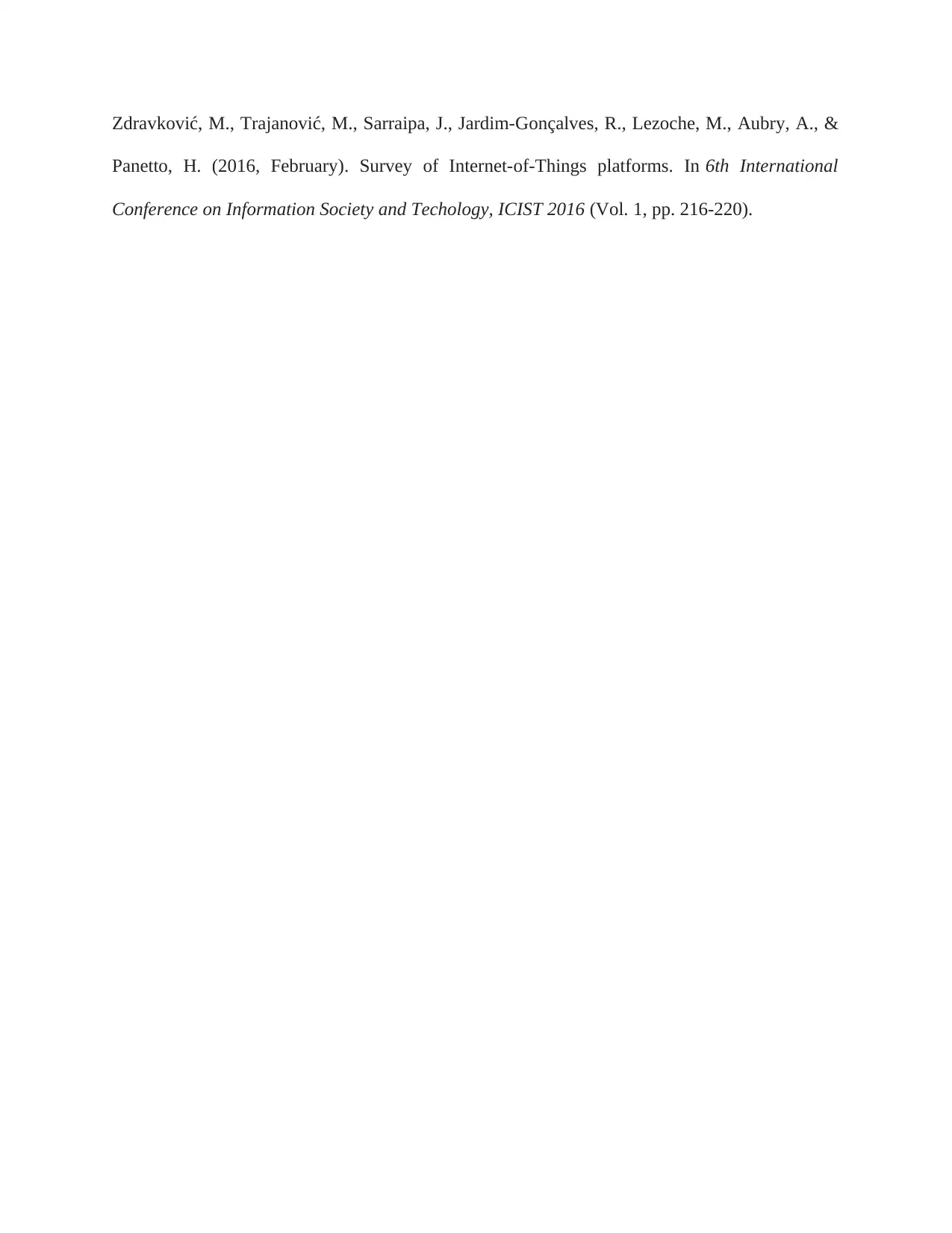
Zdravković, M., Trajanović, M., Sarraipa, J., Jardim-Gonçalves, R., Lezoche, M., Aubry, A., &
Panetto, H. (2016, February). Survey of Internet-of-Things platforms. In 6th International
Conference on Information Society and Techology, ICIST 2016 (Vol. 1, pp. 216-220).
Panetto, H. (2016, February). Survey of Internet-of-Things platforms. In 6th International
Conference on Information Society and Techology, ICIST 2016 (Vol. 1, pp. 216-220).
1 out of 16
Related Documents
Your All-in-One AI-Powered Toolkit for Academic Success.
+13062052269
info@desklib.com
Available 24*7 on WhatsApp / Email
![[object Object]](/_next/static/media/star-bottom.7253800d.svg)
Unlock your academic potential
© 2024 | Zucol Services PVT LTD | All rights reserved.





